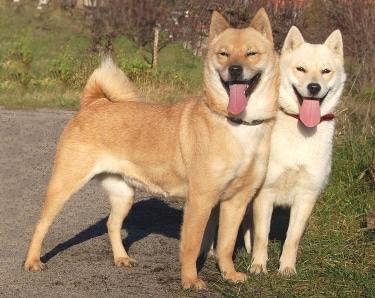
The Hokkaido (Japanese: 北海道犬) is native to the prefecture of the same name in Japan and has been used traditionally to hunt wild boar and bear.
Extremely devoted to their masters, the Hokkaido is believed to have originated from medium-sized dogs brought by the Ainu from the main island of Honshu in the 1140s. In 1869, the English zoologist Thomas W. Blankiston gave the breed the name Hokkaido.
In the early 1930s, the Hokkaido was identified as one of six primitive, indigenous Japanese dogs by cynologist, Haruo Isogai. The Nihon Ken Hozonkai (NIPPO) was formed to preserve these six breeds.
Weight: Female: 44–66 lbs (20–30 kg) Male: 44–66 lbs (20–30 kg)
Height: Female: 18–19 inches (46–48 cm) Male: 19–20 inches (48–52 cm)
Coat: Long, stiff, fur with second shorter coat of soft fur.
Color: Black, White, Brindle, Black & Tan, Sesame, Red.
Life span: 12-15 years
Temperament: Devoted, Docile, Bold, Dignified, Alert, Faithful, Brave.
Health: 30% affected by Collie eye anomaly (CEA). May be susceptible to hip dysplasia, luxating patella, heart murmurs, idiopathic seizures, anxiety, psychogenic polydipsia, and pica.
Special Interest:
• Rare outside of Japan.
• Also known as Dō-ken, Hokkaidō-inu, Hokkaidō-ken, Ainu-ken, Seta and Ainu.
• Classified as a Living Natural Monument by Japan in 1937
• One of the oldest of the six native Japanese spitz breeds that include the Akita, Shiba Inu, Kai Ken, Shikoku, and Kishu Ken.
Classifications:
Classification / standards
AKC FSS
UKC Northern Breed
FCI Group 5 Spitz and Primitive dogs, Section 5 Asian Spitz and related breeds #261
 Kennel.com – Complete Guide to Dogs The Dog Lovers Guide
Kennel.com – Complete Guide to Dogs The Dog Lovers Guide